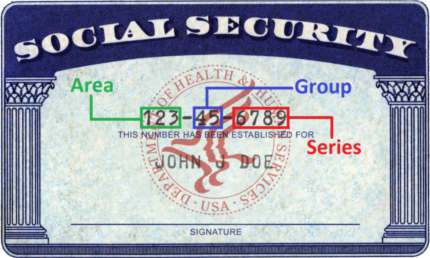 Decode Social Security Number
Decode Social Security Number
The nine-digit Social Security Number is broken into 3 parts - the Area, Group, and Series. The Area number is the first three digits of a Social Security Number, the Group number is the middle two digits and the Series number is the final four digits.
From November 1936, when Social Security Numbers were first issued until June 25, 2011 these numbers indicated when and where a Social Security Number was issued. We can even use this information to determine if a number was issued. Use our free Social Security Number Verification Tool to see if a number has been issued.
It is important to remember, these numbers indicate where a numbers was issued—not where the person was born. Social Security Numbers where not Enumerated at Birth until around 1988.
In mid-2011 the Social Security Administration began to issue Social Security Numbers randomly - doing away with the previous encoding scheme. After June 25, 2011 all newly issued numbers are randomized among the remaining un-issued, valid Social Security Numbers.
Invalid Social Security Area numbers
Some Social Security Numbers are invalid and will never be issued. Social Security Numbers beginning with 000, 333, 666 or numbers with Area number greater than 772 will never be issued. Once the remaining un-issued, valid numbers are used up we will have to change to a new numbering scheme.

Area, Group and Series numbers
Area Number - Tells you which state a number was issued in or, in some cases, to which special group the number was issued to. For instance, Social Security Numbers beginning with 700 to 728 were issued to Railroad Workers, numbers beginning with 729 to 733 were issued to naturalized citizens and some numbers beginning with 580 to 586 were issued to citizens living in Puerto Rico, the Virgin Islands, Guam, American Samoa, Northern Mariana Islands, and the Philippines.
Additionally, 9-digit numbers with first three digits greater than 899 and the 4th and 5th digits ranging from 70 to 88 are Tax Identification Numbers not Social Security Numbers.
Social Security Numbers were assigned to each state starting with the northeast states and moving southwest. The states assigned groups of numbers first were given the lowest numbers. SSN Areas were assigned in the following order:
- New Hampshire
- Maine
- Vermont
- Massachusetts
- Rhode Island
- Connecticut
- New York
- New Jersey
- Pennsylvania
- Maryland
- Delaware
- Virginia
- West Virginia
- North Carolina
- South Carolina
- Georgia
- Florida
- Ohio
- Indiana
- Illinois
- Michigan
- Wisconsin
- Kentucky
- Tennessee
- Alabama
- Mississippi
- Arkansas
- Louisiana
- Oklahoma
- Texas
- Minnesota
- Iowa
- Missouri
- North Dakota
- South Dakota
- Nebraska
- Kansas
- Montana
- Idaho
- Wyoming
- Colorado
- New Mexico
- Arizona
- Utah
- Nevada
- Washington
- Oregon
- California
- Alaska
- Hawaii
- District of Columbia
Group Number - Paired with the Area number, the Group number can be used to determine when a particular block of Social Security Numbers was issued prior to the randomization. For each Area number, Group numbers were issued in the following order:
- Odd numbers 00 to 09
- Even numbers 10 to 98
- Even numbers 02 to 08
- Odd numbers 11 to 99
- 00 is invalid
The Group numbers were used at different rates based on demand for Social Security Numbers in each areas.
Series Number - The Series number is used to ensure all issued Social Security Numbers are unique. For each Group number used the series numbers are issued sequentially from 0001 to 9999. Series number 0000 is invalid.